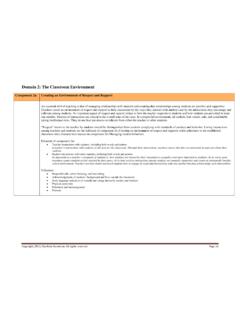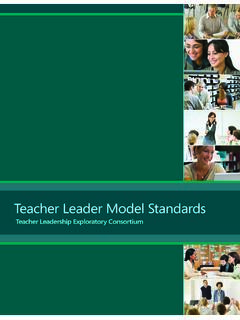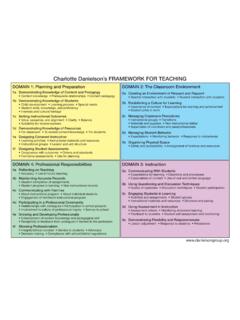Transcription of Domain 3: Instruction - Illinois State University
1 Domain 3: Instruction Component 3a: Communicating with Students Teachers communicate with students for several independent, but related, purposes. First, they convey that teaching and learning are purposeful activities;. they make that purpose clear to students. They also provide clear directions for classroom activities so that students know what to do; when additional help is appropriate, teachers model these activities. When teachers present concepts and information, they make those presentations with accuracy, clarity, and imagination, using precise, academic language; where amplification is important to the lesson, skilled teachers embellish their explanations with analogies or metaphors, linking them to students' interests and prior knowledge.
2 Teachers occasionally withhold information from students (for example, in an inquiry science lesson) to encourage them to think on their own, but what information they do convey is accurate and reflects deep understanding of the content. And teachers' use of language is vivid, rich, and error free, affording the opportunity for students to hear language used well and to extend their own vocabularies. Teachers present complex concepts in ways that provide scaffolding and access to students. Elements of component 3a: Expectations for learning The goals for learning are communicated clearly to students. Even if the goals are not conveyed at the outset of a lesson (for example, in an inquiry science lesson), by the end of the lesson students are clear about what they have been learning.
3 Directions for activities Students understand what they are expected to do during a lesson, particularly if students are working independently or with classmates, without direct teacher supervision. These directions for the lesson's activities may be provided orally, in writing, or in some combination of the two, with modeling by the teacher, if it is appropriate. Explanations of content Skilled teachers, when explaining concepts and strategies to students, use vivid language and imaginative analogies and metaphors, connecting explanations to students' interests and lives beyond school. The explanations are clear, with appropriate scaffolding, and, where appropriate, anticipate possible student misconceptions. These teachers invite students to be engaged intellectually and to formulate hypotheses regarding the concepts or strategies being presented.
4 Use of oral and written language For many students, their teachers' use of language represents their best model of both accurate syntax and a rich vocabulary; these models enable students to emulate such language, making their own more precise and expressive. Skilled teachers seize on opportunities both to use precise, academic vocabulary and to explain their use of it. Indicators: Clarity of lesson purpose Clear directions and procedures specific to the lesson activities Absence of content errors and clear explanations of concepts and strategies Correct and imaginative use of language Copyright, 2012, charlotte danielson . All rights reserved Page 30. Unsatisfactory Basic Proficient Distinguished 3a: Communicating The instructional purpose of the Teacher's attempt to explain the The instructional purpose of the lesson is Teacher links the instructional purpose of with Students lesson is unclear to students, and instructional purpose has only limited clearly communicated to students, including the lesson to the larger curriculum; the the directions and procedures are success, and/or directions and procedures where it is situated within broader learning; directions and procedures are clear and confusing.
5 Teacher's explanation must be clarified after initial student directions and procedures are explained anticipate possible student of the content contains major confusion. Teacher's explanation of the clearly and may be modeled. Teacher's misunderstanding. Teacher's explanation errors and does not include any content may contain minor errors; some explanation of content is scaffolded, clear, and of content is thorough and clear, explanation of strategies students portions are clear, others difficult to accurate and connects with students' developing conceptual understanding might use. Teacher's spoken or follow. Teacher's explanation does not knowledge and experience. During the through clear scaffolding and connecting written language contains errors invite students to engage intellectually or explanation of content, teacher focuses, as with students' interests.
6 Students of grammar or syntax. Teacher's to understand strategies they might use appropriate, on strategies students can use contribute to extending the content by academic vocabulary is when working independently. Teacher's when working independently and invites explaining concepts to their classmates and inappropriate, vague, or used spoken language is correct but uses student intellectual engagement. Teacher's suggesting strategies that might be used. incorrectly, leaving students vocabulary that is either limited or not spoken and written language is clear and Teacher's spoken and written language is confused. fully appropriate to the students' ages or correct and is suitable to students' ages and expressive, and teacher finds opportunities backgrounds.
7 Teacher rarely takes interests. Teacher's use of academic to extend students' vocabularies, both opportunities to explain academic vocabulary is precise and serves to extend within the discipline and for more general vocabulary. student understanding. use. Students contribute to the correct use of academic vocabulary. Critical Attributes At no time during the lesson Teacher provides little elaboration or Teacher states clearly, at some point If asked, students are able to explain does teacher convey to explanation about what the students will be during the lesson, what the students what they are learning and where it fits students what they will be learning. will be learning. into the larger curriculum context. learning. Teacher must clarify the learning task so If appropriate, teacher models the Teacher explains content clearly and Students indicate through their students can complete it.
8 Process to be followed in the task. imaginatively, using metaphors and questions that they are Teacher makes no serious content errors Students engage with the learning task, analogies to bring content to life. confused about the learning but may make minor ones. indicating that they understand what Teacher points out possible areas for task. Teacher's explanation of the content they are to do. misunderstanding. Teacher makes a serious consists of a monologue, with minimal Teacher makes no content errors. Teacher invites students to explain the content error that will affect participation or intellectual engagement by Teacher's explanation of content is content to their classmates. students' understanding of the students. clear and invites student participation Students suggest other strategies they lesson.
9 Teacher's explanations of content are and thinking. might use in approaching a challenge Students indicate through body purely procedural, with no indication of Teacher describes specific strategies or analysis. language or questions that they how students can think strategically. students might use, inviting students to Teacher uses rich language, offering don't understand the content Teacher's vocabulary and usage are interpret them in the context of what brief vocabulary lessons where being presented. correct but unimaginative. they're learning. appropriate, both for general Teacher's communications When teacher attempts to explain academic Teacher's vocabulary and usage are vocabulary and for the discipline. include errors of vocabulary or vocabulary, the effort is only partially correct and entirely suited to the Students use academic language usage or imprecise use of successful.
10 Lesson, including, where appropriate, correctly. academic language. Teacher's vocabulary is too advanced, or explanations of academic vocabulary. Teacher's vocabulary is too juvenile, for students. Teacher's vocabulary is appropriate to inappropriate to the age or students' ages and levels of culture of the students. development. Possible Examples At no point in the math The teacher says, Today we're going to The teacher begins the math lesson by The teacher communicates to student s 3a activity does the teacher say add single digit numbers. but does not saying, Today we are going to learn that there will be an opportunity to what they will be learning explain, model or show a visual of what has how to add 2 numbers together and explore the lesson objectives during today.





